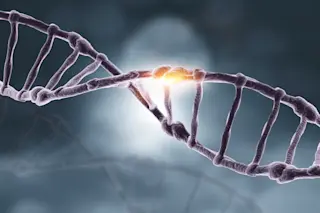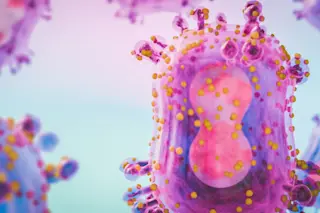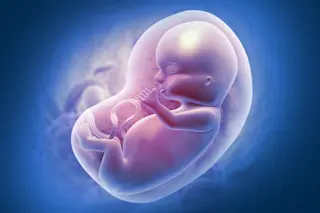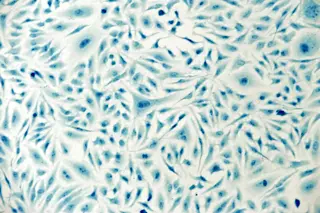Once upon a time, growing up male gave little boys a sense of certainty about the natural order of things. We had short hair, wore pants, and played baseball. Girls had long hair, wore skirts, and, no matter how hard they tried, always threw a baseball just like a girl. I grew up in the 1950s and never sensed that there might be exceptions to these rules. My parents, sticklers in matters of biological accuracy, made sure I knew that there was another difference too. A few things little boys had that little girls did not. Girls, I concluded, were nothing more than little boys who were missing a couple of parts here and there. They clearly deserved sympathy.
The idea of male completeness was reinforced in school. I still remember Mrs. Macak, my third-grade teacher, quelling a minirevolt among my female classmates. During a lesson on pronouns, she told us convention dictated that a person of unknown gender is always presumed to be male. It’s not fair! Kathy Peale (the best student in our grade) protested, to howls of delight from the other girls. You’re right, Kathy, said Mrs. Macak, smiling. But you’d better get used to it. It’s a man’s world, ladies. It’s a man’s world. In 1956 it sure was.
A few years later I began to think that my sense of male completeness had a scientific foundation: the Y chromosome.
Mr. Zong, my wonderful ninth-grade biology teacher, prided himself on being far more up-to-date than our textbook, and he made certain that his young charges understood the genetics of human sex determination. He explained that a human cell generally carries 46 chromosomes (not 48, as our outdated textbook claimed), two of which were the sex chromosomes. Females have two X chromosomes, and males have one X and one Y. If ever I needed scientific justification for the notion that males are complete and that females are missing a thing or two, there it was. Boys and girls both had the X, but only boys had a Y.
My admiration for the Y chromosome grew as I learned the extent of its influence. Although each egg cell produced by a woman carries a single X chromosome, the sperm cells produced by a man carry either an X or a Y. This means, in very simple terms, that the sperm cell determines a baby’s sex. If fertilized by a Y-carrying sperm, an egg develops into a boy; if fertilized by an X-carrying sperm, it becomes a girl. I imagined the poor little passive X chromosome sitting in the egg cell, just waiting to see whether the lucky sperm that wriggled its way through the egg’s coating carried an X or a Y. In either case, the X had to wait for the male to show up and make the decision. Made sense to me.
To top things off, even when the Y chromosome is outnumbered--as can happen when genetic errors produce such unusual combinations of sex chromosomes as XXY or XXXY--the Y is still dominant. If the embryo carries so much as a single Y chromosome, it will usually develop as a boy. The Y really is the boss.
Then I stumbled across a bothersome fact: human embryos with a single sex chromosome will continue to develop if--and only if--that chromosome is an X. If a fertilized egg is somehow stuck with a Y chromosome and no X, it’s out of luck. The embryo self-destructs very early in development. Put plainly, the Y just doesn’t have the resources that human development, male or female, requires. The X chromosome does. Embryos bearing a single X chromosome can develop into healthy (albeit infertile) adults.
The simple reason no embryo can develop without at least one X chromosome is that it’s the X, not the Y, that is loaded with important genes. The X carries many of the genes required for muscle development, blood clotting, and color vision. It even carries the gene that enables the body to respond to that most macho of all hormones, testosterone.
Men, of course, have only one copy of the X chromosome (which they inherit from their mothers). Women have two copies, one from each parent. This discrepancy is bad news for men. Because a healthy Y chromosome is not enough to counteract a defective gene on the X, men will suffer from any X-linked defect they happen to inherit. This is why color blindness, hemophilia, Duchenne muscular dystrophy, and a host of other X- linked genetic disorders--more than 200 at last count--strike men in such disproportionate numbers. Women will suffer from these disorders only if they have the rare bad luck to inherit exactly the same defect on both their X chromosomes. In most cases, though, their second X chromosome provides a good copy of the faulty stretch.
It was bad enough to realize that the Y chromosome needs help from an X to make a human being. My male pride might have withstood that shock if only the Y had a few impressive qualities of its own. Surely this chromosome, so crucial to making a human male, must bear the genes that code for bigger muscles, taller bodies, deeper voices, and all those other characteristics that men take such pride in, right? But no. The truth I was finally forced to face is that the Y chromosome is a genetic wimp.
Far from being large and powerful, the Y chromosome in humans is almost comically small. While the hefty X has some 2,500 to 5,000 genes, the Y carries only about 15. Of these few genes, only one seems to be of great significance: the one that switches on the male pattern of development, ensuring that the embryo develops testes instead of ovaries. In short, the Y is necessary--but not sufficient--to make a male. And that’s about all this wimp of a chromosome seems to do.
Why should the Y chromosome be so puny? Is it an ironic payoff for millions of years of male chauvinism? Or is it the result of a deeper, more fundamental genetic process? William Rice, a geneticist at the University of California at Santa Cruz, may have the answer. The origin of the Y chromosome, he suggests, required a Faustian bargain that may eventually exact the ultimate price from the human male genome: the loss of the Y chromosome itself.
Rice starts with the observation that wherever in the animal kingdom an X-Y system of sex determination has evolved, it is always the Y chromosome that has diminished in function. In other words, the Y always becomes a wimp.
Why? According to widely accepted theories, the X and Y chromosomes started out nearly identical, differing only in the stretch that bears a crucial sex-determining gene. But once a particular chromosome became associated with one sex, things started to change.
For openers, evolution would have favored clustering the genes that control traits beneficial to males--but harmful to females--around the sex-determining region on the Y chromosome. That clustering would increase the likelihood of these traits showing up only in males, where they confer an advantage. (For example, being brightly colored helps male guppies attract females, which outweighs the risk they run of being seen by predators. But such flamboyance in female guppies is just an ad that says Eat me.) Simple enough. So over time the stretches abutting the sex- determining region of the Y became increasingly different from the corresponding segments on the X.
Eventually, as the X and the Y became more different, they also stopped recombining--that is, they stopped swapping genes during meiosis, the process of cell division that produces eggs or sperm and generally ensures genetic diversity within a species. During meiosis, all the chromosome pairs line up and are copied. Then all the pairs separate twice, yielding eggs or sperm that carry only half the original number of chromosomes. In males the X and the Y are separated so that each sperm cell receives either an X or a Y but not both.
When most chromosomes pair up during meiosis, they spend a little time recombining with each other. A few genes from, say, Dad’s chromosome 6 may be swapped with the corresponding genes from the same segment in Mom’s chromosome 6. Thus recombination shuffles the genetic deck, producing new combinations of genes in an individual’s eggs or sperm. This not only provides for a little variety, it also allows bad genes to be swapped for good genes. If a gene in one copy of chromosome 6, for example, is somehow damaged, that does not mean the whole chromosome is forever flawed. A few generations down the road, the faulty gene may be swapped during recombination for a working copy.
In short, by shuffling genes between chromosomes, recombination tends to prevent errors from piling up on a single chromosome. And in theory it was through recombination, coupled with natural selection, that genes beneficial to males gradually accumulated on the Y chromosome. But once these genes clustered on the Y chromosome, recombination between the X and the Y was no longer advantageous. Consider what could happen if the X and the Y did recombine: those male-beneficial genes on the Y could suddenly find themselves on an X chromosome, about to be inserted in the nucleus of a female embryo, where their function would be most unwelcome. In fact, the sex-determining gene itself could be swapped onto the X, making the X into a Y and the Y into an X. A genetic disaster waiting to happen.
Put simply, if the sex chromosomes in an X-Y system swapped genes freely, females would always run a high risk of inheriting harmful genes. So natural selection has tended to weed out organisms in which recombination between sex chromosomes was not suppressed.
But suppressing recombination has a price, Doctor Faustus. Consider this: if the X and the Y cannot recombine, it means that a damaged gene on one sex chromosome cannot be swapped for a healthy gene during recombination. For the X, this is not a problem, because it can still recover by recombining with another X chromosome when it is passed along to a female in succeeding generations. For the Y, however, the outlook is grim. Always paired with an X chromosome with which it cannot recombine, the Y accumulates one mistake after another as it is passed from father to son.
As genes on the Y become badly damaged, their functions get taken over by genes carried on other chromosomes. The Y chromosome slowly shrinks in function, until nearly all but the sex-determining gene has been discarded.
Taken to its ultimate extreme, this process should eliminate the Y chromosome altogether. The result: a species where females are XX and males are XO. (This system, where O signifies the absence of a second sex chromosome, has already evolved in some fruit flies and fish.) The defining genetic feature of maleness would be the lack of something--a chromosome. Sound familiar?
Preventing recombination, according to this line of reasoning, is what ultimately brings about the demise of the Y. That’s an interesting concept, but like many ideas in evolutionary biology, it cannot be tested. At least that’s what everyone thought. But William Rice hit on a way to test the theory. After all, it wasn’t sex per se but lack of recombination that supposedly led to the decline of the Y, and so the theory could be tested in male fruit flies, whose chromosomes never swap genes during meiosis. (In fruit flies, genes are shuffled between chromosomes only in females.)
Rice loaded the male flies’ two largest chromosomes with genetic markers. Then he selectively bred these male flies with females, making sure to retain and breed only those male offspring in which the marked genes were preserved. He then followed these chromosomes in male flies through 35 generations. By doing this, he was re-creating the Y chromosome’s predicament: being passed on from one generation of males to the next with nary a hope of recombination.
What happened? Exactly as theory had predicted, the pseudo-Y chromosomes suffered a series of debilitating mutations in each of five separate experiments. By the end of 35 generations, these chromosomes were measurably less fit than chromosomes in fruit flies that had been allowed to breed normally. Simply by preventing genetic recombination, Rice had driven a couple of healthy chromosomes straight downhill. As he pointed out, the same principle should apply to any chromosome that cannot recombine--a chromosome like, say, the human Y.
If Rice is correct, and I cannot see any reason to suspect he’s not, then the human Y chromosome is well on its way to the vanishing point. The price that the Y pays for its role in sex determination is the loss of the ability to repair itself through recombination. And without recombination, as Rice’s work shows, the Y has already started down its slippery slope to oblivion.
It seems that sex, despite the best of intentions, can never be made entirely safe, even for the genes that determine it. In addition to suffering the pain and indignities of sex-linked genetic diseases, human males carry a wimpy little chromosome that shows every sign of going down for the count.
The grim biology of my once-beloved Y chromosome makes it difficult to escape the thought that things have come full circle since 1956. If I had the chance to go back to third grade, I might try to convince Kathy that life wasn’t so unfair after all. Faced with the ultimate demise of our one unique little bit of genetic information, I could argue that the male pronoun rule was nothing more than partial compensation for the genetic weaknesses we unlucky boys endure. I’m sure she’d understand.














